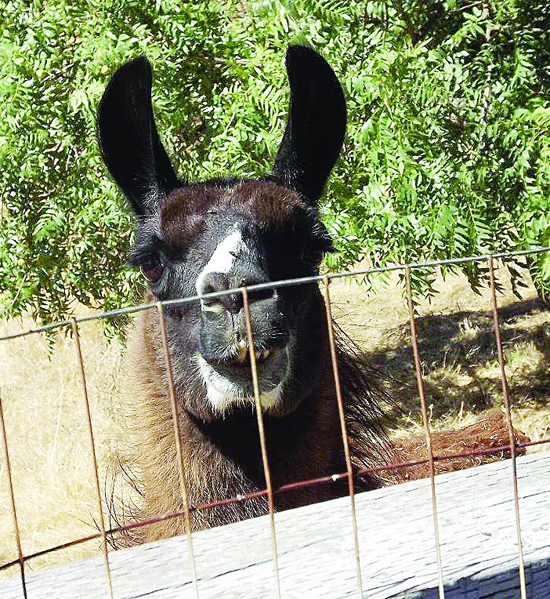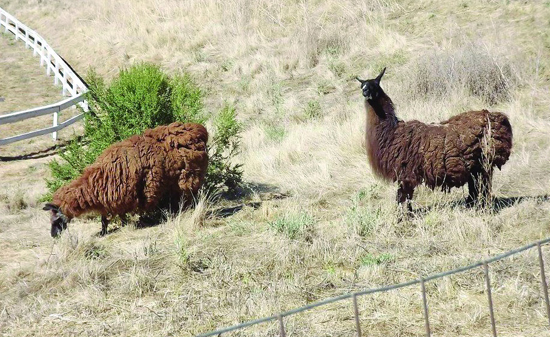 | | | One local llama gets up close, and personal. Photos Cathy Dausman
| | | | | | Area residents may be accustomed to seeing turkey, deer, quail, coyote, fox and the occasional skunk, but who knew there were llamas in Lamorinda? Arlene, the "Llama Mama," does - she keeps two on a parcel of land snugged up against a west-facing hillside.
 Llama Mama acquired the pair in 1997 from a Hayward widower who sought foster families to care for the small herd his wife once kept. To protect the animals' safety, Arlene asked that Lamorinda Weekly not use her last name.
Llama Mama acquired the pair in 1997 from a Hayward widower who sought foster families to care for the small herd his wife once kept. To protect the animals' safety, Arlene asked that Lamorinda Weekly not use her last name.
 "Last summer a group of young boys came and I caught them throwing stones at the llamas' heads. I scared them off but it could have been awful if a stone had hit one of their beautiful big eyes," she said in an email. The llama pair, Tahoe and Tonapa (or Tony) are half-brothers who seek shade in the barn when it gets too hot.
"Last summer a group of young boys came and I caught them throwing stones at the llamas' heads. I scared them off but it could have been awful if a stone had hit one of their beautiful big eyes," she said in an email. The llama pair, Tahoe and Tonapa (or Tony) are half-brothers who seek shade in the barn when it gets too hot.
 Tony is a bit more social around humans, but thanks to their keen eyesight, both are "very nosey and very alert," Arlene said. She advises to wait for the llamas to approach, rather than approach them. "[Llamas] are gentle souls and have a wonderfully soothing presence about them." They are very curious, she added, and will often gently exhale on your face.
Tony is a bit more social around humans, but thanks to their keen eyesight, both are "very nosey and very alert," Arlene said. She advises to wait for the llamas to approach, rather than approach them. "[Llamas] are gentle souls and have a wonderfully soothing presence about them." They are very curious, she added, and will often gently exhale on your face.
 Arlene said her pair escaped once, running "across the lane and up the hill in the opposite pasture, but [they] came back on their own at dusk." She also said they respond favorably to music. "They come when I call 'la-la-la-llama' and they love it when I sing "Danny Boy" to them."
Arlene said her pair escaped once, running "across the lane and up the hill in the opposite pasture, but [they] came back on their own at dusk." She also said they respond favorably to music. "They come when I call 'la-la-la-llama' and they love it when I sing "Danny Boy" to them."
 When nervous or upset, the llamas make a humming sound, and when feeling threatened, she said they stand head to tail, side by side, evoking an image of the fictitious Dr. Doolittle-inspired two-headed llama.
When nervous or upset, the llamas make a humming sound, and when feeling threatened, she said they stand head to tail, side by side, evoking an image of the fictitious Dr. Doolittle-inspired two-headed llama.
 "Llamas are camelids (two-toed, cud-chewing mammals)," explained veterinarian Jamie Peyton. They have slender necks and long legs, and adult males weigh over 400 pounds. Both llama and alpaca are domesticated South American pack animals, whose thick coats are used to make rugs or clothing. Nearly 260,000 llama and alpaca were imported to North America by the 1990s; millions more live in the Andes mountain countries today.
"Llamas are camelids (two-toed, cud-chewing mammals)," explained veterinarian Jamie Peyton. They have slender necks and long legs, and adult males weigh over 400 pounds. Both llama and alpaca are domesticated South American pack animals, whose thick coats are used to make rugs or clothing. Nearly 260,000 llama and alpaca were imported to North America by the 1990s; millions more live in the Andes mountain countries today.
 Peyton keeps both llamas and alpacas on her Sacramento Valley area ranch. She said both llama and alpaca are very social animals, and unlike sheep, will care for each other's offspring. "They are good 'Aunties,'" Peyton said. She also said llamas are careful guardians, and will 'sing' to alert the pack if they detect the presence of predators, including coyotes.
Peyton keeps both llamas and alpacas on her Sacramento Valley area ranch. She said both llama and alpaca are very social animals, and unlike sheep, will care for each other's offspring. "They are good 'Aunties,'" Peyton said. She also said llamas are careful guardians, and will 'sing' to alert the pack if they detect the presence of predators, including coyotes.
 If they break into a chorus of "Danny Boy" you'll know its Tahoe and Tony!
If they break into a chorus of "Danny Boy" you'll know its Tahoe and Tony!

|

